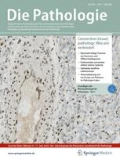Zusammenfassung
Chronisch-entzündliche Darmerkrankungen weisen eine zunehmende Inzidenz auf und betreffen meist jüngere Menschen in kritischen Lebensphasen. Eine frühe Diagnosestellung sowie eine daraus resultierende schnelle und effiziente Therapieeinleitung sind daher essenziell. In Deutschland hat sich hier das akzelerierte „Step-up“-Vorgehen durchgesetzt, eine schnelle Therapieeskalation bei fehlendem Ansprechen mit früher Einleitung einer immunsuppressiven Therapie. Trotz neuer Therapiestrategien fehlen für eine Subgruppe von Patienten weitere medikamentöse Optionen. Zukünftig könnten für diese Subgruppe die Adhäsionsmolekülantikörper eine neue Therapiemöglichkeit darstellen. Um jedoch primär eine individuelle Therapieplanung zu ermöglichen, ist die Identifizierung von Prädiktoren, die den weiteren Krankheitsverlauf zuverlässig vorhersagen, unabdingbar. Sollten sich die Transkriptomdaten der CD8+-T-Zellen prospektiv bestätigen, steht hier in absehbarer Zukunft ein wichtiger Biomarker zur Verfügung.
Abstract
There is a continuously increasing incidence in inflammatory bowel diseases affecting mostly young people who are in a vulnerable phase of life. Thus, early diagnosis and initiation of an effective therapeutic regimen is critical in order to maintain a good quality of life. In Germany, the standard therapeutic strategy is an accelerated step up approach, including the introduction of early immunosuppressive therapy if required. Although novel therapeutic strategies have found their way into clinical use there is still a substantial subgroup of patients where effective therapy is lacking. The future introduction of anti-adhesion molecule antibodies might provide a realistic option for this subgroup. Equally important is the availability of predictive markers allowing stratification of patients into subgroups at the time of diagnosis. Assuming that the CD8+ T cell transcriptome approach will be confirmed in prospective trials, personalized therapy in patients with inflammatory bowel disease will be the next step.

Literatur
Beaugerie L, Seksik P, Nion-Larmurier I et al (2006) Predictors of Crohn’s disease. Gastroenterology 130:650–656
Colombel JF, Sandborn WJ, Reinisch W et al (2010) Infliximab, azathioprine, or combination therapy for Crohn’s disease. N Engl J Med 362:1383–1395
Cosnes J, Cattan S, Blain A et al (2002) Long-term evolution of disease behavior of Crohn’s disease. Inflamm Bowel Dis 8:244–250
D’Haens G, Baert F, Van Assche G et al (2008) Early combined immunosuppression or conventional management in patients with newly diagnosed Crohn’s disease: an open randomised trial. Lancet 371:660–667
Dignass A, Van Assche G, Lindsay JO et al (2011) The second European evidence-based consensus on the diagnosis and management of Crohn’s disease: current management. J Crohns Colitis 4:28–62
Dignass A, Bokemeyer B, Adamek H et al (2009) Mesalamine once daily is more effective than twice daily in patients with quiescent ulcerative colitis. Clin Gastroenterol Hepatol 7:762–769
Ghosh S, Goldin E, Gordon F et al (2003) Natalizumab for active Crohn’s disease. N Engl J Med 348:24–32
Hoffmann JC, Preiss JC, Autschbach F et al (2008) Clinical practice guideline on diagnosis and treatment of Crohn’s disease. Z Gastroenterol 46:1094–1146
Kruis W, Kiudelis G, Racz I et al (2009) Once daily versus three times daily mesalazine granules in active ulcerative colitis: a double-blind, double-dummy, randomised, non-inferiority trial. Gut 58:233–240
Lee JC, Lyons PA, Mckinney EF et al (2011) Gene expression profiling of CD8+ T cells predicts prognosis in patients with Crohn disease and ulcerative colitis. J Clin Invest 121:4170–4179
Louis E, Mary JY, Vernier-Massouille G et al (2012) Maintenance of remission among patients with Crohn’s disease on antimetabolite therapy after infliximab therapy is stopped. Gastroenterology 142:63–70
Mckinney EF, Lyons PA, Carr EJ et al (2010) A CD8+ T cell transcription signature predicts prognosis in autoimmune disease. Nat Med 16:586–591, 581p following 591
Molodecky NA, Soon IS, Rabi DM et al (2012) Increasing incidence and prevalence of the inflammatory bowel diseases with time, based on systematic review. Gastroenterology 142:46–54
Romberg-Camps MJ, Dagnelie PC, Kester AD et al (2009) Influence of phenotype at diagnosis and of other potential prognostic factors on the course of inflammatory bowel disease. Am J Gastroenterol 104:371–383
Sandborn WJ, Colombel JF, Enns R et al (2005) Natalizumab induction and maintenance therapy for Crohn’s disease. N Engl J Med 353:1912–1925
Seow CH, Stempak JM, Xu W et al (2009) Novel anti-glycan antibodies related to inflammatory bowel disease diagnosis and phenotype. Am J Gastroenterol 104:1426–1434
Targan SR, Feagan BG, Fedorak RN et al (2007) Natalizumab for the treatment of active Crohn’s disease: results of the ENCORE Trial. Gastroenterology 132:1672–1683
Van Assche G, Dignass A, Reinisch W et al (2010) The second European evidence-based Consensus on the diagnosis and management of Crohn’s disease: Special situations. J Crohns Colitis 4:63–101
Van Assche G, Van Ranst M, Sciot R et al (2005) Progressive multifocal leukoencephalopathy after natalizumab therapy for Crohn’s disease. N Engl J Med 353:362–368
Interessenkonflikt
Die korrespondierende Autorin weist auf folgende Beziehungen hin:
Die Autorin ist im Advisory Board von Abbott GmbH & Co. KG und MSD und hat Vortragshonorare von den Firmen Abbott GmbH & Co. KG, MSD, Dr. Falk Pharma GmbH und Ferring Arzneimittel GmbH erhalten.
The supplement this article is part of is not sponsored by the industry.
Author information
Authors and Affiliations
Corresponding author
Rights and permissions
About this article
Cite this article
Siegmund, B. Chronisch-entzündliche Darmerkrankungen. Pathologe 33 (Suppl 2), 211–214 (2012). https://doi.org/10.1007/s00292-012-1641-5
Published:
Issue Date:
DOI: https://doi.org/10.1007/s00292-012-1641-5

